|
Playa del what??
|

|
Mexico's Caribbean coast is one of the best remedies for the Winter blues. Millions of people go every year to Cancún in the Yucatan Peninsula, and for good reason.
I don't like Cancún. I don't like the Zona Hotelera with tens of miles of hotels-fortresses, each of them with a crowded pool deck facing the beach, with a wall spoiling the view. No way.
As much as I found Cancún impersonal, cold and intimidating, the Playa is friendly, warm and welcoming. The crowd is also more European in composition.
|
|
|

|
|
|
This small town is located some 70 km (that's forty-something miles, for the non-metric crowd) south of Cancún and avoids overdevelopment (for how long?), offering something for everyone. I really like it: the location, the beach, the town, food (and drinks) and, first of all, all these nice people who treat you well because you are a guest in their town, not just because you are bringing money (although the latter is also welcome, thank you).
|
|
|
Have a look at some of the pictures I brought back from a week-long stay in Playa back in '98 (with three more visits between '99 and '01).
|
|
|
Practical information follows the pictures near the bottom of the page.
|
|
|
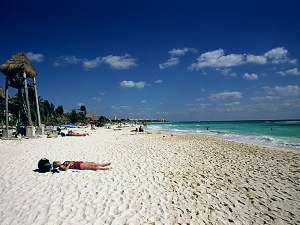
|
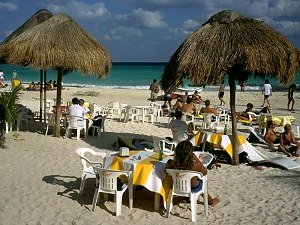
|
|
The beach at Playa is prettier than in Cancún and not spoiled by highrise hotels (although the Playacar development nearby may change this). Beware of those awful French women without bikini tops...
|
There is no distinct line between the beach and bars or restaurants. Enjoy a breakfast on the beach (the happy hour starts in the morning), try guacamole con totopos, and get a good supply of beer!
|
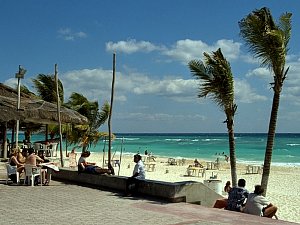
|
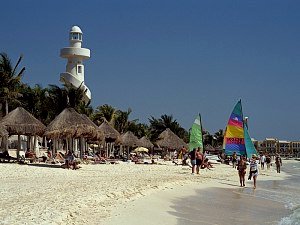
|
|
Most of the Eat-West streets end at the beach, so that you are never far from the ocean... and refreshments.
|
As opposed to Cancún with its under-siege atmosphere, the beach in Playa is friendly and open for everyone to mix.
|
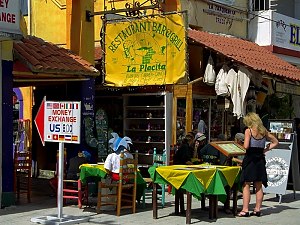
|
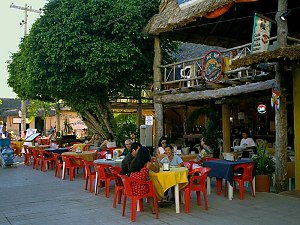
|
|
Many restaurants post the menus outside, in English and Spanish. The food (Mexican and Mayan) is good, and so is the service. Money exchange points abound, but a banking machine offers a better rate.
|
Finding a place to eat, even after midnight, is no problem. This is one of my favorites: Pez Vela, with a live music on some nights. A flamenco floor show is presented once a week here.
|
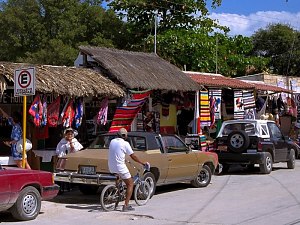
|
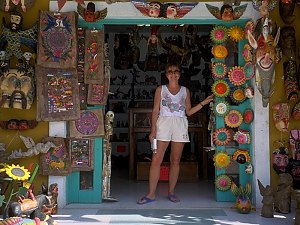
|
|
In small souvenir stores you may haggle, as long as you do it with a smile. Done right, the vendors will like you more: selling you the stuff is just part of the fun. The prices are lower than in Cancún.
|
Local stores offer something for every taste and pocket, and the business is booming, which adds to the festive atmosphere.
|
|
How to get there
|

|
Many airlines fly to Cancún; the airport is quite busy though clean, nice and civilized.
A taxi from the airport to Playa del Carmen will cost you less than US $25. All drivers I've met were honest and polite, and the fares are often posted at taxi stands (or in the cabs).
There are frequent buses between Cancún and Playa, and tickets are three or four dollars apiece. The bus terminal in Playa is situated at the intersection of the two main streets, within walking distance from almost anywhere.
|
|
Money
|
|
|
Many shops and restaurants do not accept credit cards, so a supply of pesos may come handy. There are at least three ATM locations at Avenida Juarez, a few minutes walk from the beach, and they are both on Cirrus and Plus networks.
A money-changer will change your greenbacks into pesos (some will even give you a credit card advance), but the exchange rate is a tad worse.
Last but not least, many services will accept payment in U.S. dollars, although be prepared to lose about 5% on the unavoidable rate round-down.
|
|
Getting around
|
|
|
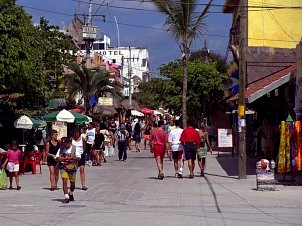
|
Getting around Playa del Carmen is easy: you need to know just two streets. The main East-West street, Avenida Juarez, ends at the beach, with a number of restaurants and small stores scattered about. Other E-W streets are referred to by numbers: Calle 4, Calle 5, etc.
The main pedestrian promenade and a tourist hangout is Avenida 5, running South-North, parallel to the beach. Here (and in nearby side streets) are most of the hotels, restaurants and shops.
|
|
|
Renting a car does not make much sense: it would stay idle most of the time. The taxis are easily available and inexpensive, and the bus service in the Cancún-Tulum corridor, frequent and dirt-cheap.
|
|
What to do
|

|
My favorite pastime on the beach is very simple: doing nothing. If you are a more active type, there is swimming, snorkeling, scuba diving (with lessons available), parasailing (got to try it one day!) - refer to the guidebooks listed below for details.
If you are after night life, you will find some clubs or discos, too. For the quiet types, eating out and shopping possibilities are plentiful.
A day trip to the nearby island of Cozumel is an easy choice: the ferry service from Playa offers more than twenty departures daily. There are also quite many side-trips within a reasonable bus or taxi ride: the Mayan ruins at Tulum (with a beautiful, secluded beach below), wildlife sanctuary at Xcaret, the manicured lagoon in Xel-Ha — take your pick.
Or take a bus (or taxi) ride to the nearby Jardin Botánico and watch free-roaming spider monkeys in their natural environment (a short trail into the forest just outside the compound is the best opportunity).
|
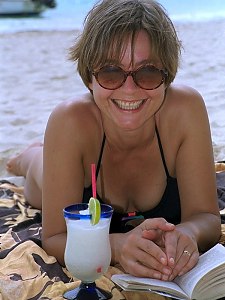
|
|
Where to stay
|
|
|
Stay away from the big resorts (located, thanks God, out of town) and you should be just fine. The guidebooks and Web pages listed below give a wide choice of accommodations ranging from $10 to $300 a night.
I was quite happy staying at The Treetops, 50 meters from the beach. A nice, small hotel run by an American couple, on very cramped (and very green) grounds; not much to write back home about, but friendly, clean and quite inexpensive: U.S. $80 or so a night in high season, and this was the most expensive room they had. The place got a facelift in '99.
The Pelicano Inn, built around a patio opening onto the beach, is a relaxed, no-nonsense hotel, charging about $80 per double in high season, including the best buffet breakfast in town. I've stayed with them in '2000 and I like the place.
In 2001 we've stayed in Hotel Costa Del Mar, next to the beach north of downtown. We made our bookings in the last moment and got a bungalow: close to the water, but generally disappointing. Their regular hotel part seems better, though.
|
|
Eating out
|
|
|
It is difficult to have a bad meal in Playa del Carmen. There is a wide choice of restaurants and snack bars, and all the food I've tried was fresh, well-prepared and served both properly and friendly. Still, after some time I've settled down on three favorites:
|
|
|
-
Ronnie's (formerly Ted's Mescaleros) at the Pelicano Inn, right on the beach, at Calle 6. Relaxed breakfasts, fresh guacamole con totopos, well-made tropical drinks served from 8AM. Live music on some nights.
In late 1999 the place got a new management, but the food and the ambience are like before.
-
Pez Vela on Avenida 5, with the tables upstairs overlooking the ground level and the street. A friendly place right in the middle of the action; good for a couple of drinks or a casual dinner (just avoid the bathrooms!). Live music on some night, and a very good house band.
-
El Chino, located on Calle 4 two blocks from Avenida 5 (where the crowds are) has less trendy location but the food is quite enjoyable and less expensive than at similar places on the beaten path; certainly worth checking out.
For a quiet, romantic dinner in a candlelit patio I would recommend The Limones (a little bit more formal and expensive, but still quite reasonable, and accepting credit cards).
|
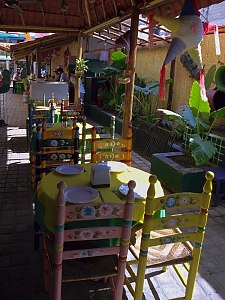
|
|
My favorite place, La Placita,
closed back in 2000. Too bad...
|
|
What to eat
|
|
|
Both Spanish-Mexican and Mayan food is available, and both kinds are prepared in the most satisfactory fashion. Here are just some of my favorites:
-
Guacamole con totopos — tortilla chips with avocado. Doesn't sound like much, but try them here; you'll never go back to the supermarket kind. Make sure you also get some salsa (with an obvious choice between salsa americana and salsa mexicana), or ensalada of chopped tomatoes, onions and peppers. Wash this down with a beer, or better two.
-
Ceviche — chopped fish (not really raw, because marinated in lime juice) with tomatoes, onions and some other green stuff. (Shrimp may be used instead.) Very good.
-
Sopa de pollo y limon — a lime-flavored chicken soup, a small meal by itself, nutritious and delicious.
-
Cochinita pibil — pork: lean, moist, well-done, very aromatic and nicely spiced, baked in a wrapper of banana leaves. (Pork is delicious there, and the reason must be the free-ranging pigs; you can see them when passing through smaller villages.) A similar dish is also made out of chicken.
-
Xtabentún — a traditional Mayan liquor, based on honey and flavored with anise; goes well with your espresso after dinner.
Desserts are also good; at The Limones I had one of the best desserts in my life; the problem is I have no clue what it was. Well, you will have to try them all...
|
|
Photography
|

|
This is a pretty and colorful place; take lots of film! An inexpensive underwater camera might be a good idea, too.
You can buy Kodak and Fuji film in many places around town. The Omega chain photo store at Avenida Juarez has a good choice of film and some of the clerks speak some English. They also offer one-hour processing not worse than that in the States at somewhat lower prices.
With most airport security nowadays flatly refusing to hand-check your film, buying and processing it at the spot makes a lot of sense. Or take a plunge and go digital!
|
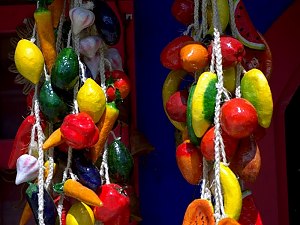
|
|
Guidebooks
|
|
|
I have checked eight different ones. Forget the big-name American travel publishers; the best two books to take along are Cancún Handbook from Moon Publications (lots of background and practical information, very nice layout) and Cancún Cozumel from Ulysses Books (more of a reference, fits into a back pocket). Get both.
|
|
Web resources
|
|
|
|
|
Alternatives
|
|
|
Isla Mujeres is my close second favorite. Snorkelers and the outdoors crowd will like Akumal (I don't), and if Playa is too crowded for you, try the Tulum village more to the South (Cabanas Ana y Jose may be somewhat more expensive than other places to stay, but you'll like the place).
|
|
A pilgrimage: the Maya world
|

|
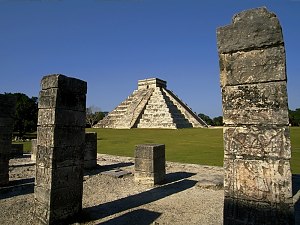
|
Yucatan is the home land of the Mayas. You have to make a trip to the most famous Mayan site: Chichen-Itza.
A day tour by bus is the last resort; you will enjoy the place much more if you spend a night or two in the nearby village of Piste; see the place early in the morning, without the bus crowds and while it is still not too hot.
|
|
|
Taking a local bus for a day trip to Tulum is another nice option, allowing you to combine Mayan sightseeing with few hours on a lovely (and not crowded) beach. One day is enough.
Or take a bus to Coba (west of Tulum): the city ruins are less spectacular than Chichen-Itza, but more mysterious and much less crowded. Staying at the enjoyable Villa Archeologica there is a great value for money. I would plan for two nights there, with a lazy lunch or dinner in the small village restaurant, just to watch the life go by. Plus, where else you can meet an alligator at the lake right in the center of the village?
|
|
1999 update
|
|
|
In April '99 I dropped by to Playa del Carmen again, and liked it at least as much as before. The place got a little bit more crowded, but the town is still friendly and charming as ever, food good, beach lazy and beautiful.
|
|
2000 update
|
|
|
Playa gets addictive: last January I've stopped there again on the way back from Belize and Guatemala. The place is booming; in a few years it may be overrun by tourists and large operators. So far it managed to keep most of its easygoing, friendly character.
|
|
2002 update
|
|
|
My wife and I made another trip to Playa last year. The business is booming, the town is expanding (especially to the North), but essentially things are the same. This year we're taking a break from this friendly place, but in 2003 — who knows?
|

|

|

|

|
You may also want to see my Gallery pages on the Mexico's Caribbean coast, Tulum, Chichen-Itza, and Isla Mujeres.
|
Pictures and text © 1998-2002 by J. Andrzej Wrotniak;
feel free to link to this page or to use the pictures for non-commercial purposes.
Photographs taken with a Minolta 600si SLR camera (mostly with a Tokina 20-35mm lens)
or with an Olympus Stylus Epic; film scanned to a Kodak Photo CD,
reduced and touched up with Corel PhotoPaint.
|


















